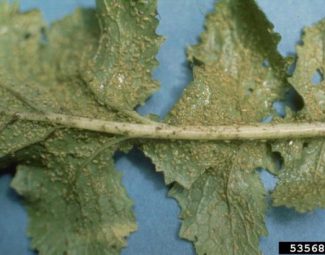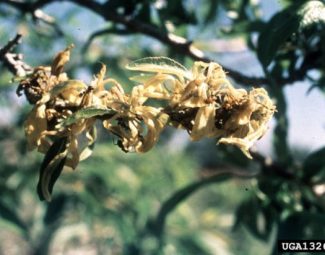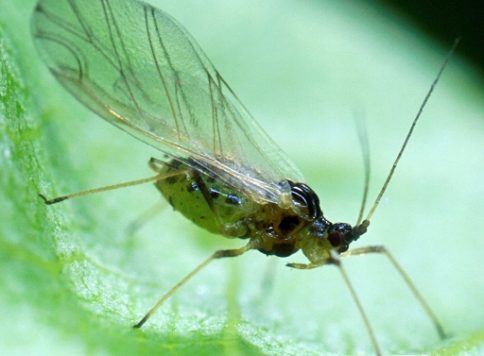Aphid
Insect Summary Report
Aphid (multiple species)
Also known as PLANT LICE or GREENBUGS
General Information
- Over 250 different species of Aphids exist worldwide. Most are host specific, but some have broad host ranges that can be as many as 100+ plant species.
- Capable of both sexual and asexual reproduction (parthenogenesis).
- Many species reproduce sexually on one host species of plant, and asexually on another.
- Vector for many plant diseases, especially viruses.
- Pierce host plants and suck sap. Excrete sticky sugar as waste product on host that can serve as growth media for black “sooty mold”. Large populations can reduce yields by depleting plant sap. Sooty mold also reduces exposure to sunlight and can decrease photosynthetic activity.
- Some species live in symbiotic relationship with ants. Ants feed on excreted honeydew, and provide protection from natural enemies of aphids.
- Capable of developing resistance to insecticides very quickly.
- Parasitised nymphs appear as white balls called “mummies”.
- During sexual reproduction, females release a sex pheromone that attracts males.
Life Cycle (4-10 days for Sexual Maturity)
- Eggs… Usually produced by sexual reproduction.
- Nymphs… Vary in color according to species and time of year. Have two spiny projections in rear of body called “cornicles”. Slow moving. Number of molts varies from species to species. In high populations, shedded skins produce white, fluffy or waxy appearance on plant. Nymphs produced asexually reach reproductive maturity in as little as 5 days. Offspring can begin to be produced when mother is still an embryo.
- Adults… 1.5-3.5 mm in length. Can be winged or wingless. Winged adults often associated with sexual reproduction. Vary in color according to species and time of year. Capable of producing 3-6 parthenogenic nymphs per day for a period of approximately 3-4 weeks. Usually reproduce sexually in fall months and during periods of high population or other environmental stresses.
Over-wintering Strategy
Mostly overwinter as sexually produced eggs, but some species overwinter as adults.
Organic Control
- General Info
- Protective screens or plastic. Reflective plastic mulches have been shown to reduce aphid infestations.
- Augmentative releases of natural predators such as:
- Hippodamia convergens (ladybug)
- Chrysoperla carnea (lacewing)
- Orius tristicolor (minute pirate bug)
- Commonly Used Products
- Ferti-Neem Oil
- Ferti-Organic Karanja Oil
- Biorepel (Garlic Oil)
- Ecotrol Plus (Rosemary and other essential oils)
- Various Oils: Trilogy, Tritek
- Soaps: Des-X
- BoteGHA ES (Biological)
- Mycotrol ESO (Biological)
- Neemix 4.5 (Botanical)
- Sil-Matrix
Cultural Control
- Maintain good fertility and mineral balance in plants. Identify macro- and micronutrient deficiencies by performing plant tissue and soil analysis. Adjust for deficiencies with foliar and soil applied applications of appropriate fertilizers.
- Where possible, plant during times of historically low populations.
- Maintain uniform stands.
More Images of Aphids
Bibliography
- Images by Whitney Cranshaw, Colorado State University, Bugwood.org (multiple life stages of pea aphid and green peach aphid, green peach aphid damage – leaf curling, small pea aphid colony, including Syrphid fly larvae, aphid predatory midge, and green peach aphid attacked by parasitoid )
- Images by Jim Baker, North Carolina State University, Bugwood.org (green peach aphid adults, green peach aphid nymph)
- Image by Phil Sloderbeck, Kansas State University, Bugwood.org (adult pea aphid)
- Clemson University – USDA Cooperative Extension Slide Series, Bugwood.org (adult pea aphid on alfalfa and adult pea aphid on clover)
- R.J. Reynolds Tobacco Company Slide Set, R.J. Reynolds Tobacco Company, Bugwood.org (green peach aphid)
- Image by Eugene E. Nelson, Bugwood.org (infestation)
- Image by Scott Bauer, USDA Agricultural Research Service, Bugwood.org ( alate (winged) green peach aphid adult)
- Blackman, R. L. and V. F. Eastop. 1984. Aphids on the World’s Crops, An Identification Guide. John Wiley & Sons, New York. 466 pp.
- Pettersson, J. (1970) An aphid sex attractant. I. Biological studies. Entomol. Scand., 1, 63–73.
- Drees, Bastiaan M., Professor and Extension Entomologist Texas A&M University, Website Publication http://insects.tamu.edu/extension/publications/html/uc031.html (life cycle, host range, disease vector, conventional control).
- K. Bürgel, C. Daniel, E. Wyss (2005) Effects of autumn kaolin treatments on the rosy apple aphid, Dysaphis plantaginea (Pass.) and possible modes of action
Journal of Applied Entomology 129 (6) , 311–314 doi:10.1111/j.1439-0418.2005.00968.x - Smith, F.F., & R.E. Webb. 1969. Repelling aphids by reflective surfaces, a new approach to control of insect-transmitted viruses. In: Maramorosch, K., ed. Viruses, Vectors, and Vegetation. John Wiley & Sons, NY. pp. 631-639
- James J. Stapleton and Charles G. Summers, Reflective mulches for management of aphids and aphid-borne virus diseases in late-season cantaloupe (Cucumis melo L. var. cantalupensis), Crop ProtectionVolume 21, Issue 10, December 2002, Pages 891-898












